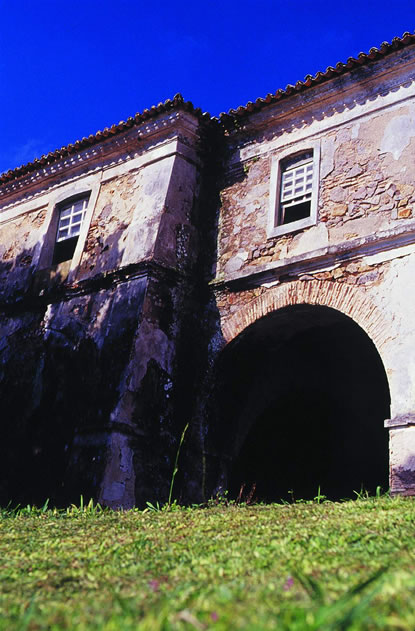Discovering the fortresses of the Island of Santa Catarina

Barracks of the Santa Cruz de Anhatomirim Fortress
 razil is a country of continental dimensions. In the region of Florianópolis, in southern Brazil, a group of fortresses helped to build a nation with such a large territory. Part of this set of buildings was recovered from ruin and is under the care of the Universidade Federal de Santa Catarina (UFSC). The buildings are now considered secular historical monuments.
razil is a country of continental dimensions. In the region of Florianópolis, in southern Brazil, a group of fortresses helped to build a nation with such a large territory. Part of this set of buildings was recovered from ruin and is under the care of the Universidade Federal de Santa Catarina (UFSC). The buildings are now considered secular historical monuments.
More than 500 years ago, Brazil was a colony of Portugal with little definition of its exact dimensions. To the south, the Portuguese vied for control of the region with Spain. The Spaniards had been exploring wealth, such as gold and silver, from their own colonies in America. The estate was transported by boats along the Rio da Prata – the estuary that divides the territories that are today Uruguay and Argentina (countries of Spanish colonization). At the end of the 15th century, Portugal and Spain had already established an imaginary line that divided America in two, through the Treaty of Tordesillas. However, with the discovery of other lands and new wealth in the west of the continent, the Portuguese intended to invade the territory that, by agreement, belonged to Spain.
José da Silva Paes (Lisbon, 25 of October of 1679 – Lisbon, 14 of November of 1760) was a military and engineer who was sent to Brazil by the Portuguese Crown to work in the administration of the Portuguese colony in Southern Brazil. In order to protect the territory from Spain, he designed and built the fortresses that constituted the main defense system of the Island of Santa Catarina. Besides that, he was also responsible for the construction of geopolitical guidelines to guarantee the Portuguese presence in Prata River and Rio Grande do Sul. In 1739, he was designated first governor of the newly created captaincy of Santa Catarina, a position he held for 10 years.

These territorial disputes caused the Portuguese Crown to build fortresses in South America. Some were built in the current state of Rio Grande do Sul. Many of these buildings disappeared over time. In Santa Catarina, a state whose capital is Florianópolis, some fortresses have withstood time and were recovered. The biggest one is the Santa Cruz de Anhatomirim Fortress – an entire fortified island located in the north bay in Florianópolis. This fortification was built in 1739, initiating the region’s defense strategy.

The Santa Cruz de Anhatomirim Fortress
Over time, the Portuguese completed an entire system that came to have almost 30 buildings dedicated to the defense of the island of Santa Catarina. Among the main ones, we can mention, besides Anhatomirim, the São José da Ponta Grossa Fortress, the Santo Antônio de Ratones Fortress, the Nossa Senhora da Conceição de Araçatuba Fortress, the Sant’Anna Fort and the Santa Bárbara Fort.
Three of these buildings (Anhatomirim, Ratones and São José) have been under the care and management of UFSC for over 40 years. They have become tourist and cultural centers that receive around 200,000 people annually. These fortresses, due to their strategic and military position, became known as the North Bay Defensive Triangle.

The North Bay Defensive Triangle: (1) the Santa Cruz de Anhatomirim Fortress; (2) the São José da Ponta Grossa Fortress and (3) the Santo Antônio de Ratones Fortress
When can I visit the fortresses?
The fortresses managed by UFSC can be visited from Tuesday to Sunday, including holidays, from 8:30 AM to 6:30 PM (local time).
Is There an Entrance Fee?
Yes! To enter the fortresses there is an entrance fee.
Children aged 6 to 12 years old pay R$8.00
Visitors 13 years old and older pay R$16.00.
Children under 5 and adults over 60 can visit the fortresses for free.
However, on the last Sunday of each month, from March to November, you can visit any fortress for free!
Locations of the fortresses:
The São José da Ponta Grossa Fortress is located on Praia do Forte, in the north of Florianópolis, and can be accessed by land.
The Santa Cruz de Anhatomirim Fortress and the Santo Antônio de Ratones Fortress, on the other hand, are located, respectively, on the islands of Anhatomirim and Ratones Grande, on the North Bay of Santa Catarina Island.
UFSC is not responsible for transporting visitors to the island fortresses (Anhatomirim and Ratones). For these, you will need to contact a specific company that acts in the region.
(Click here to see more information about the companies that are responsible for that).
See also:
- Virtual tour – São José da Ponta Grossa Fortress – a serie of ten videos about the fortress on YouTube.
- The International Database on Fortifications and the Portuguese -Spanish fortified system in the southern border of Brazil in the 18th century – article from Almeida Internarional Seminar 2014 (text in English on the last pages)
- Coordenadoria das Fortalezas da Ilha de Santa Catarina – website of the departmet that works directly with the fortresses (in Portuguese)
- Virtual tour – São José da Ponta Grossa Fortress – a presentation in Portuguese
- Virtual tour – Santa Cruz de Anhatomirim Fortress – a presentation in Portuguese
- Virtual tour – Santo Antônio de Ratones Fortress – a presentation in Portuguese






